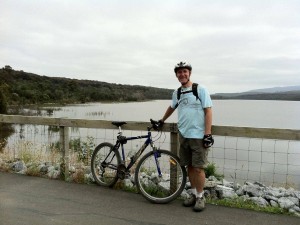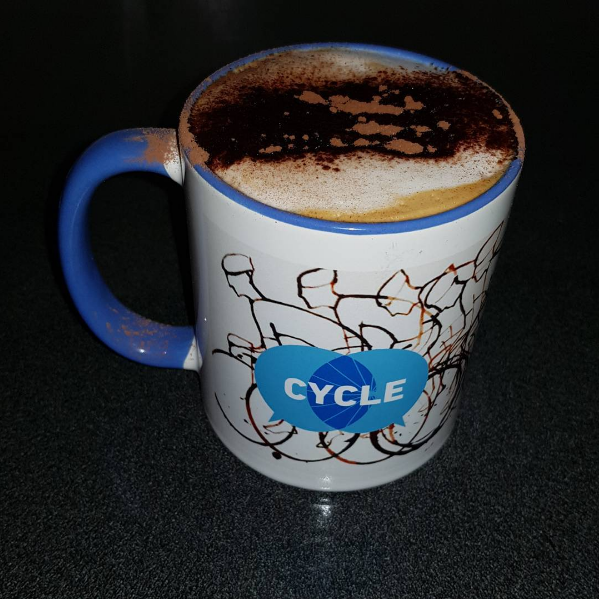Every now and then I learn of concerns for people who are deaf and cycle. Only recently, there has been an article in The Guardian of a deaf cyclist’s views, experience and ambitions (http://www.theguardian.com/environment/bike-blog/2016/apr/15/im-deaf-but-it-doesnt-stop-me-cycling ). Some people have expressed the view it was a good article. But I struggle to understand why deaf cycling is really a matter of concern.
Nearly 35 years ago, in my early teens, I was diagnosed with a bilateral sensorineural deafness. At that time I was enjoying adventures on my bike with my mates, as well as other physical activity such as driveway cricket. Can’t blame mandatory helmet laws for that not being as popular these days!

About 15 years ago, I gained some educational qualifications in disability. I had previous qualifications and work experience in technology, but wanted to move over into the “softer” side of things. I wanted to put emphasis on “people” over “things”.
Lately, coming onto 10 years now it must be, I’ve been using bicycles for transport as well as recreation. I have not owned a private motor vehicle in that time, but I have maintained my licence and volunteered for some community driving. These days though, it is extremely rare for me to get behind the wheel of a motor vehicle. I rely on bicycles and public transport to get around.
I think my personal experience and qualifications make me entitled to comment and express my views on the matter of deaf cycling. As far as I’m concerned, deafness is irrelevant in many aspects of life. At least, I wish it was! It is not a danger physically, but socially is another matter. Like any disability, the effects of deafness really result from the interaction of people’s actions and decisions – it is “social”.
There are two main theories of disability: the Social Model of Disability, and the Medical Model of Disability. (http://www.pwd.org.au/student-section/the-social-model-of-disability.html https://en.m.wikipedia.org/wiki/Social_model_of_disabilityhttps://en.m.wikipedia.org/wiki/Medical_model_of_disability )
The United Nations’ Convention on the Rights of Persons with Disabilities is based on the Social Model. (http://templatelab.com/convention-on-the-rights-of-persons-with-disabilities/ )
The Social Model defines the “physical, attitudinal, communication and social barriers” to participation and involvement in society, including the built environment and transportation systems. These environments and systems are designed and built by people.

The Medical Model of Disability emphasises a person’s “physical or mental attributes that some institutions view as needing to be fixed”, eg use of a hearing aid while riding. This places the emphasis and responsibility on the individual for their adjustment and behavioural change. It implies the person is doing wrong and is not normal if they cannot adapt to the environment they find themselves in, whereas the Social Model implies we’re all in it together. I argue that people who refer to deafness as a problem or danger or as a barrier, or talk about increasing perception from other senses, would be thinking in terms of the medical model and do not consider deafness as normal.
With regards to cycling specifically, there is no real problem of deafness except perhaps for close bunch riding. I don’t see what difference hearing (or the lack of it) makes when pushing pedals. With close bunch riding, views of the road and surrounds are severely restricted, and riders require quick reactions to changes made by other riders. General group riding has a looser structure. Whether riding in a group or individually, “bikeability” for urban design should ensure that the roads and built environment are safe for everyone to ride.
I compare relying on hearing with relying on private motor-vehicle transport. There are nearly always other options which would be as effective if not more effective.
Let’s discuss some specific matters that are often mentioned with respect to deaf cycling.
Headphones as a distraction? Cycling Victoria’s Code of Conduct for Training Cyclists recommends against them: “Portable Audio Devices Do not use these devices whilst riding. You need to be aware of your total environment and be able to hear what’s around you when riding. This is even more critical in a group ride.” I do not agree with the wording of this. Specifically, whether the phrase “be able to hear what’s around you when riding” is true or not, it is redundant after the previous phrase (“be aware of your total environment”). The emphasis on hearing to the exclusion of other senses and functions is unnecessary. The phrasing of this paragraph in the Code of Conduct should be changed to eliminate mention of hearing. (http://vic.cycling.org.au/Portals/17/Admin/COC%20Training%20Cyclists.pdf )
Group too spread out for leader to maintain proper leadership? When a Duty of Care applies, the ride leader cannot or should not absolve themself of the responsibility to proactively know how ride participants are faring. I have tried mirrors to assist with knowing how other riders in the group are faring. They are not much useful in practice, as well as being subject to damage rendering them totally useless.
 2 Way Radios have recently been used in several groups of cyclists with whom I ride. I am not in favour of this practice. These devices are not inclusive of all riders and abilities. Their usage is restricted in practice to the clique. They provide no documented record of communication that can be used to defend against claims of breach of Duty of Care. Mobile phones are much more inclusive and provide records of communication, if not the actual communication than metadata about the communication (eg time and date of call and number dialled). Messaging systems, whether they are a feature of the phone itself or a downloaded application, also, by their nature provide an independent record. A good ride leader would ensure a situation does not develop where they have already lost track of ride participants for whom they owe a duty of care. This includes rides publicised as “no drop” where the leading section will wait for straggling riders.
2 Way Radios have recently been used in several groups of cyclists with whom I ride. I am not in favour of this practice. These devices are not inclusive of all riders and abilities. Their usage is restricted in practice to the clique. They provide no documented record of communication that can be used to defend against claims of breach of Duty of Care. Mobile phones are much more inclusive and provide records of communication, if not the actual communication than metadata about the communication (eg time and date of call and number dialled). Messaging systems, whether they are a feature of the phone itself or a downloaded application, also, by their nature provide an independent record. A good ride leader would ensure a situation does not develop where they have already lost track of ride participants for whom they owe a duty of care. This includes rides publicised as “no drop” where the leading section will wait for straggling riders.
 Close passing by motor vehicles can be a shock for any rider. It would be very rare for hearing to be the sole assistance for a rider to prepare for a vehicle to close pass. The road rating and the type of vehicles that use it should give notice to the rider where to position themself and allow for the possibility of close passing. If positioning on the road is not safe for a deaf person, it is not safe for anyone!
Close passing by motor vehicles can be a shock for any rider. It would be very rare for hearing to be the sole assistance for a rider to prepare for a vehicle to close pass. The road rating and the type of vehicles that use it should give notice to the rider where to position themself and allow for the possibility of close passing. If positioning on the road is not safe for a deaf person, it is not safe for anyone!
My major concern with hearing impairment and cycling is the difficulty of knowing the mechanical condition of the bike. I believe a bicycle should not make any noise during normal operation. Hearing sounds emanating from a bike, such as the drivetrain, provides a clue about the condition of the bike. However, it is possible to get a feel for the bike, and sense vibrations and other clues to the condition of the bike.
Lip reading while riding with other cyclists is a challenge! Where do I look?- where I’m going or at the other rider talking? Where do they look?- at me or where they are going? Sometimes, it is better to just shut up and ride!
Any incidents I have had on my bike have had no direct relationship to my hearing status. I completed a Cycling Victoria Leading Rider Course, largely to allay other cyclists’ concerns about my ability to ride with them. (http://www.vic.cycling.org.au/Riding/Leading-Rider)
If deaf cycling is such a danger, how am I still here cycling?

